The Most Useful Rope Knots
for the Average Person to Know
Multi-Loop Knots
To see more details in the pictures, zoom in by holding down the CTRL key and pressing + several times.
Restore by holding down the CTRL key and pressing 0.
|
The
Home Page
describes some knotting terminology, and it explains a number of factors which affect the security of the knots that you tie. Always keep in mind that there are risks associated with ropes and knots, and the risks are entirely your own.
Site Map
Multi-Loop Knots
Two loops can sometimes be more secure than a single loop because they provide a double hold on an object. When lifting or lowering a person, a double-loop knot can be used as a sling. In addition, sometimes it's handy to have a triple-loop knot. In a rescue situation, for example, you can put the injured person's legs through two of the loops and then put the third loop around his or her back.
Practice tying your favorite knots periodically (from different angles) so that you'll remember how to tie them when you need them.
Here are some multi-loop knots:
- ABOK #1100 or Double Splayed Loop in the Bight
URL: http://daveroot.neocities.org/knots/Knots_MultiLoops.html#ABOK1100
This knot creates two loops.
Ashley referred to this as a double splayed loop in the bight, and it's listed as #1100 in
The Ashley Book of Knots
(hence the name "ABOK #1100"). To tie this knot, start with a loose
Alpine Butterfly
(picture 1). In picture 1, notice that there's a tall loop sticking straight up the middle, and there are two other loops on the sides of the tall vertical loop. Bring those two loops through the tall vertical loop (picture 2). Bring the tall vertical loop toward you and down so that it lays below the rest of the knot (picture 3). Carefully dress and set the knot (picture 4).
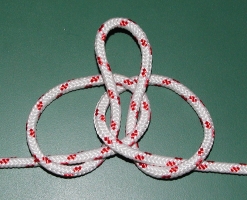 -1 -1
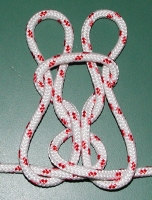 -2 -2
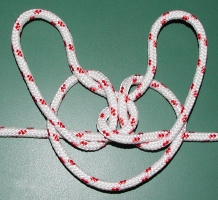 -3 -3
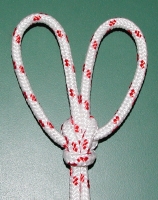 -4 -4
In
The Complete Rigger's Apprentice
(p.59), Brion Toss says that "This knot (Figure 3-17) is a little tricky to tie, but its splayed loops make it preferable to the
Bowline on the Bight
for some slinging applications (ladders, pallets) and for sitting in. Either knot is good as an emergency bosun's chair."
- Birmingham Bowline
URL: http://daveroot.neocities.org/knots/Knots_MultiLoops.html#BirminghamBowline
This variation of the
basic Bowline
creates two or more loops.
First tie a
basic Bowline
(picture 1) and then continue around to tie a second
Bowline
(picture 2). You can add as many more loops as you desire by tying more
Bowlines.
Dress and set the knot (picture 3).
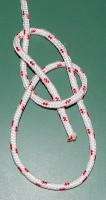 -1 -1
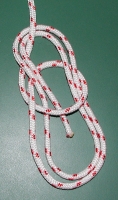 -2 -2
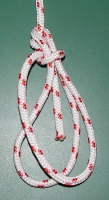 -3 -3
If you're familiar with the
basic Bowline
then the Birmingham Bowline is easy to remember how to tie, and it's fairly easy to tie, and it's fairly easy to dress, and it's easy to untie after it has been under a strain. Also, it's versatile because it can either be tied
before
the loops are put to use, or else you can pass the end of the rope around an object as you create the knot. One disadvantage of this knot is that it can't be tied in the middle of a rope (when you don't have access to the ends of the rope).
I haven't been able to find any strength ratings for this knot, but if you need to pass the rope around an object while tying a multi-loop knot then this might be a knot to consider.
- Bowline on the Bight or ABOK #1080
URL: http://daveroot.neocities.org/knots/Knots_MultiLoops.html#BowlineontheBight
This is a double-loop variation of the
basic Bowline.
To tie this knot, create a small loop in a doubled rope (similar to a
basic Bowline),
and bring the end of the doubled rope up through the small loop (picture 1). This creates two big loops which hang below the knot (where the
basic Bowline
has only one big loop). Now open up the end of the doubled rope and bring it down and around over the two main loops (picture 2), and then continue bringing it up above the small initial loop (picture 3). Dress and set the knot (picture 4). Now it looks like a
Double-Knotted Bowline
but with two loops instead of only one.
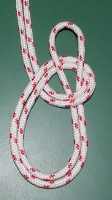 -1 -1
 -2 -2
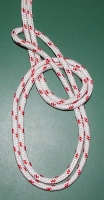 -3 -3
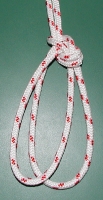 -4 -4
If you know how to tie the
basic Bowline
then the Bowline on the Bight is fairly easy to remember once you get the hang of it. It's easy to tie and easy to dress, and it's easy to untie after it has been under a strain, and the two loops can be re-sized fairly easily. It's generally considered to have the same strength rating as the
basic Bowline.
Ashley says that "It is the knot generally used at sea for lowering an injured man from aloft."
(The Ashley Book of Knots,
p.194, #1080). As Ashley points out, this knot has a long track record of use in rescue situations, so it's considered by many sailors and rescue workers to be a strong enough knot to be used when lives are at stake. Ashley also points out that the pull on the two ends should be approximately parallel, which is a potential disadvantage that the
Double Alpine Butterfly
doesn't have.
According to Budworth, "all sailors sooner or later are faced with some urgent improvisation. This is one such knot, which can be used for lowering an injured person and other emergencies. One leg is put through each loop and the patient (if conscious and capable) holds tight onto the rope at chest level, or is somehow secured to it. It reduces the strength of the line in which it is tied by up to 40%."
(The Complete Book of Knots,
p.38).
In
The Complete Rigger's Apprentice,
Brion Toss says that the Bowline on a Bight "is not entirely dependable when the strain comes on one part only or when the two standing parts are pulled in opposite directions. In the former instance, make a Bowline on a Bight with a
Bowline
on it [i.e. tie off the end of the rope with a
Bowline,
somewhere above the knot formed by the Bowline on a Bight] (Figure 3-14B). In the latter instance try a different knot such as the Farmer's Loop (Figure 3-15) or the
Butterfly Knot
(Figure 3-16)." (p.58, brackets added).
- Double or Triple Alpine Butterfly
URL: http://daveroot.neocities.org/knots/Knots_MultiLoops.html#DoubleAlpineButterfly
This knot creates two or more loops.
To tie a Double Alpine Butterfly, wrap the rope several times around your hand so that you have
four
strands of rope laying on the palm of your hand (picture 1 below). The two strands in the middle (strands 2 and 3) will become the loops, so make them as big as they need to be (as in picture 1). Grab the left-most strand (#1 in picture 1) and bring it all the way to the right over all of the other strands (pictures 1 and 2). Now grab the
two
left-most strands (#2 and #3 in picture 3) and bring them all the way to the right over all of the other strands (pictures 3 and 4). After bringing strands 2 and 3 over the other strands, push those two back to the left
under
the other strands (picture 5). You can dress and set the knot into an end-line loop configuration (picture 6), and if you pull the two ends in opposite directions then the knot will form itself into the Alpine Butterfly configuration (picture 7).
 -1 -1
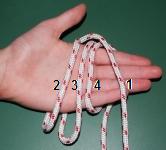 -2 -2
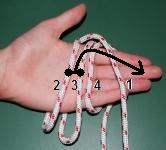 -3 -3
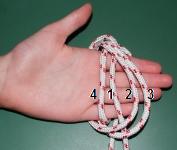 -4 -4
 -5 -5
 -6 -6
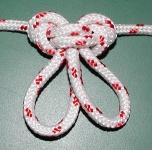 -7 -7
To tie a Triple Alpine Butterfly, wrap the rope several times around your hand so that you have
five
strands of rope laying on the palm of your hand (picture 1 below). The three strands in the middle (strands 2, 3, and 4) will become the loops, so make them as big as they need to be (as in picture 1). Grab the left-most strand (#1 in picture 1) and bring it all the way to the right over all of the other strands (pictures 1 and 2). Now grab the
three
left-most strands (#2, #3, and #4 in picture 3) and bring them all the way to the right over all of the other strands (pictures 3 and 4). After bringing strands 2, 3, and 4 over the other strands, push those three back to the left
under
the other strands (picture 5). Again, you can dress and set the knot into an end-line loop configuration (picture 6), and if you pull the two ends in opposite directions then the knot will form itself into the Alpine Butterfly configuration (similar to picture 7 above).
 -1 -1
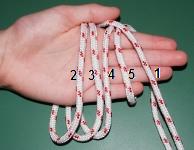 -2 -2
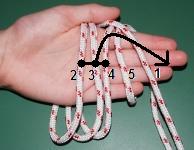 -3 -3
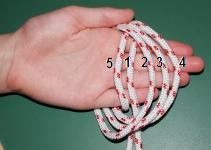 -4 -4
 -5 -5
 -6 -6
The Double and Triple Alpine Butterfly seem to have all of the advantages and disadvantages of the
Alpine Butterfly,
except that they can't easily be made in such a way that you're able to pass the loops around an object while you're tying the knot. However, this is probably not something which needs to be done very often.
Note: When an Alpine Butterfly is dressed into the end-line loop configuration shown in picture 6 (above), the forces at work within the knot are different than the forces at work within the Alpine Butterfly configuration (picture 7 above). Therefore, the end-line loop configuration is best thought of as a separate knot from the Alpine Butterfly. These two knots are topologically equivalent, but they distribute the forces differently and therefore they potentially have different strength/security considerations. Since the end-line loop configuration in picture 6 has never been named (as far as I'm aware), and since it's formed by dressing the Alpine Butterfly a little differently, it seemed simplest to show the two configurations together.
- Double or Triple Double Dragon
URL: http://daveroot.neocities.org/knots/Knots_MultiLoops.html#DoubleDoubleDragon
This knot creates two or more loops.
Method #1
This is a variation of the
Double Dragon
which turns it into a double-loop knot. First begin tying the normal
Double Dragon
as in pictures 1 and 2. Then push
two
bights
through the small loop on the right (instead of just one, as in the
single-loop Double Dragon)
(picture 3). Essentially you're creating a "slipped"
Double Dragon
(for more on a "slipped" knot, see the
Slip Knot).
At this point I find that it's helpful to tighten the knot a bit before continuing (picture 4). Now take the small loop which is sticking out to the left in picture 4 and bring it to the right and over the two (or more) main loops until it's behind the main loops (picture 5). Bring that loop all the way around until it lays below the knot (picture 6). You can now easily change the sizes of the loops, then finish dressing and setting the knot (picture 7).
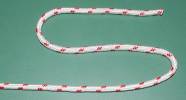 -1 -1
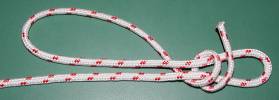 -2 -2
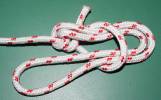 -3 -3
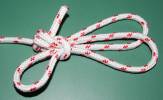 -4 -4
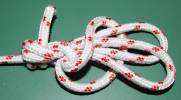 -5 -5
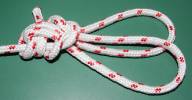 -6 -6
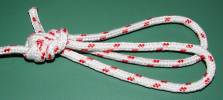 -7 -7
To tie a Triple Double Dragon, first begin tying the Double Double Dragon as in pictures 1, 2, and 3 (above). To make this a triple loop, simply take the end of the
bight
which is pointing towards the left in picture 3 (above) and bend it back to the right and push it through the knot (picture 1 below). As picture 1 (below) shows, you now have three
bights
pointing towards the right (these will become the main loops) and two
bights
pointing towards the left. At this point I find that it's helpful to tighten the knot a bit before continuing (picture 2). Now take the two loops which are on the left in picture 2 and bring them over to the right and around the three main loops until they're behind the three main loops (picture 3). This is similar to the way that the Double Double Dragon is formed (above). Bring those two loops all the way around until they lay below the knot (picture 4). You can now change the sizes of the loops fairly easily before dressing and setting the knot (picture 4).
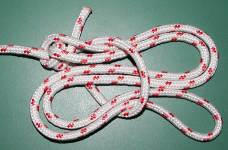 -1 -1
 -2 -2
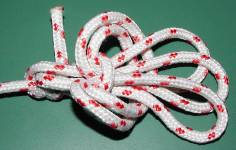 -3 -3
 -4 -4
This method makes it easy to convert a
single-loop Double Dragon
into a double-loop Double Dragon, and to convert a double-loop Double Dragon into a triple-loop Double Dragon.
Method #2
Here's an alternate way to tie the Double Double Dragon which allows you to create two or more loops around an object
while
you tie the knot (rather than
after
you tie the knot as with Method #1). Begin by tying the first few steps of the
single-loop Double Dragon
until you reach a configuration similar to picture 1 (below). You now have a
bight
of rope laying across your fingers with a strand of rope coming through it. Pass the end of the rope into the
bight,
then over the top and around the
bight,
then back out of the
bight
again as in picture 2. In picture 2, notice that you've tied a
Reef Knot.
Now you simply finish tying a
single-loop Double Dragon
in the normal way by passing the end of the rope around the object again, then passing the end of the rope into the
bight
and around your fingers until it lays over the tops of the two strands of rope on your fingers (picture 3). Wrap the end of the rope twice around the two strands of rope on top of your fingers and then tighten the knot, just like you would do with the
single-loop Double Dragon
(picture 4). In picture 4, pull out the strand of rope which you created in picture 2, and use it to adjust the relative sizes of the two loops which have been passed around the object, then finish dressing and setting the knot (picture 5).
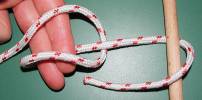 -1 -1
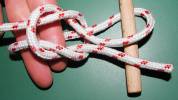 -2 -2
 -3 -3
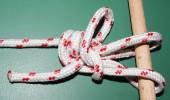 -4 -4
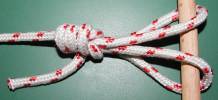 -5 -5
To make three or more loops, tie the knot until you finish picture 2, then pass the end of the rope around the object (to make the second loop around the object). Now follow picture 2 again to pass the end of the rope into the
bight,
then over the top and around the
bight,
then back out of the
bight
again, then pass the end of the rope around the object for the third time, and so on.
The Double and Triple Double Dragon seem to have all of the advantages and disadvantages of the
single-loop Double Dragon.
- Double or Triple Figure-Eight Loop or ABOK #1085
URL: http://daveroot.neocities.org/knots/Knots_MultiLoops.html#DoubleFigureEightLoop
This knot creates two or more loops.
To tie a Double Figure-Eight Loop, start with a "slipped"
Figure-Eight Loop
(pictures 1 and 2), which creates two loops where there would normally have been only one loop (for more on a "slipped" knot, see the
Slip Knot).
Slightly open up the end of the doubled rope which is sticking up at the top in picture 2 and pass it all the way around the two main loops and over the knot, as in pictures 3, 4, 5, and 6. Dress and set the knot (picture 7). Make sure to dress the knot properly so that all of the strands of rope are parallel to each other and don't cross over each other unnecessarily.
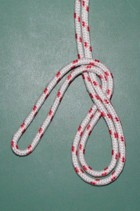 -1 -1
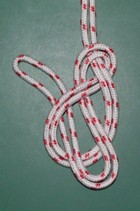 -2 -2
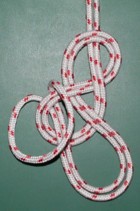 -3 -3
 -4 -4
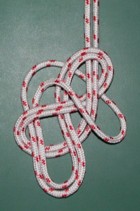 -5 -5
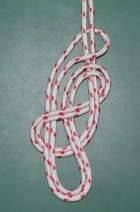 -6 -6
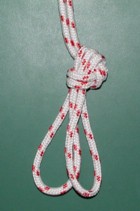 -7 -7
To tie a Triple Figure-Eight Loop, start as in pictures 1 and 2 above, which creates two loops where there would normally have been only one loop. Then take the end of the doubled rope which is sticking up at the top in picture 2 (above) and bring it up and around the main part of the rope and tuck it through the same opening in which you had tucked the other two loops (picture 1 below). Dress and set the knot (picture 2 below). Make sure to dress the knot properly so that all of the strands of rope are parallel to each other and don't cross over each other unnecessarily.
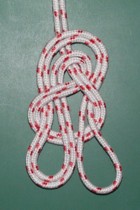 -1 -1
 -2 -2
The Double and Triple Figure-Eight Loop seem to have all of the advantages and disadvantages of the
Figure-Eight Loop,
except that they can't easily be made in such a way that you're able to pass the main loops around an object while you're tying the knot. However, this is probably not something which needs to be done very often.
- French Bowline or Portuguese Bowline or ABOK #1072
URL: http://daveroot.neocities.org/knots/Knots_MultiLoops.html#FrenchBowline
This is another variation of the
basic Bowline
which can create two or more loops.
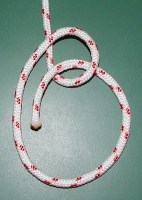 -1 -1
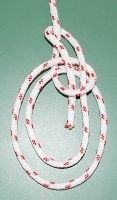 -2 -2
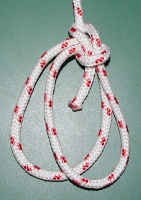 -3 -3
The French Bowline is slightly easier to tie than the
Birmingham Bowline,
and it seems to have basically the same advantages and disadvantages as the
Birmingham Bowline.
One disadvantage with the French Bowline is that it's fairly easy for one of the loops to get bigger and the other loop to get smaller. This can potentially pose a hazard when hoisting or lowering people or heavy objects because it might allow the load to shift.
The French Bowline is also called the Portuguese Bowline in some books and websites, but I've seen other websites (such as
this one)
which describe the Portuguese Bowline slightly differently. Rather than bringing the end of the rope
through
the small loop in picture 1, you bring the end of the rope
on top of
the small loop. According to some people, this is the difference between the French and Portuguese Bowlines. I haven't been able to find any strength ratings for the French or Portuguese Bowlines, but they would appear to have a similar strength rating as the
basic Bowline
because the core knot configuration is the same.
- Karash Double Loop
URL: http://daveroot.neocities.org/knots/Knots_MultiLoops.html#KarashDoubleLoop
This knot creates two loops.
Start with a
Figure-Eight Loop
(picture 1). Slightly open up the end of the doubled rope which is sticking down at the bottom in picture 1 and bring it up and all the way over the knot, as in picture 2. Grab the two strands of rope which are marked with a yellow square in picture 2 and pull them out (picture 3) to become the two loops for this loop knot (picture 4).
 -1 -1
 -2 -2
 -3 -3
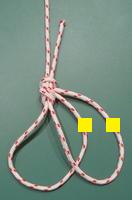 -4 -4
The
Karash Double Loop
website describes the use of this knot for rescue purposes, including links to some test data for this knot. It also contains a link to this
YouTube video
which demonstrates several ways of quickly making rescue harnesses with this knot. It appears to be quick to tie, and easy to untie after it has been under a strain, and it appears to be a strong and secure rescue knot.
- Spanish Bowline or ABOK #1087
URL: http://daveroot.neocities.org/knots/Knots_MultiLoops.html#SpanishBowline
This knot creates two loops.
First double the rope to create a long
bight
(an open loop), then bring the end of the
bight
back behind the main part of the rope to create two loops (picture 1) and give each loop a twist (picture 2). Then take the loop on the left and move it over to the right
inside
of the loop on the right (picture 3). The "X" (the crossed ropes) in picture 3 is on the outside, on
top
of the two vertical lines of rope. Picture 3 shows four "loops," and you extend the two bottom "loops" and bring them up and through the two upper loops to form the two main loops (picture 4). Dress and set the knot (picture 5).
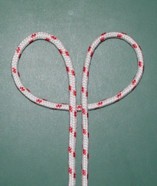 -1 -1
 -2 -2
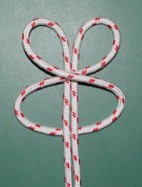 -3 -3
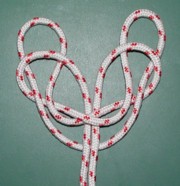 -4 -4
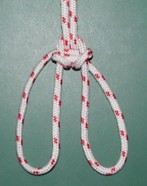 -5 -5
One advantage is that the Spanish Bowline can be tied in the middle of a rope when you don't have access to the ends of the rope (unlike the
Birmingham Bowline
and the
French/Portuguese Bowlines).
However, it might be possible for the loops to change sizes (posing the same hazard as the
French/Portuguese Bowlines),
and it can be difficult to remember how to tie this knot when you need it.
I haven't been able to find any strength/security ratings for the Spanish Bowline.
- Triple Bowline
URL: http://daveroot.neocities.org/knots/Knots_MultiLoops.html#TripleBowline
This knot creates three loops.
If you know how to tie the
basic Bowline
then the Triple Bowline is easy to remember because it's tied exactly like a
basic Bowline.
The only difference is that you tie the knot using a doubled rope (a long
bight),
then you extend the end of the
bight
until it becomes a third loop.
 -1 -1
 -2 -2
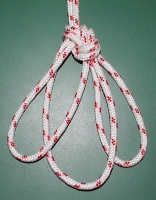 -3 -3
The Triple Bowline can be tied in the middle of a rope when you don't have access to the ends of the rope, but I haven't been able to find any strength/security ratings for this knot.
According to Budworth, "The triple bowline can be used to make a sit sling, chest sling or full harness."
(The Complete Book of Knots,
p.92).
- Triple Crown or Three-Part Crown in the Bight or ABOK #1097
URL: http://daveroot.neocities.org/knots/Knots_MultiLoops.html#TripleCrown
This is a "splayed" double-loop knot similar to the
ABOK #1100 double loop
and the
Spanish Bowline.
In other words, the two loops hang apart from each other rather than laying on top of each other.
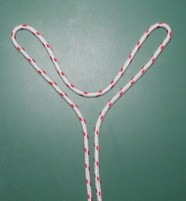 -1 -1
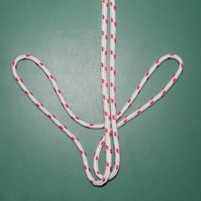 -2 -2
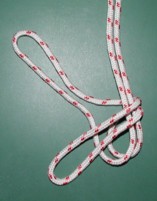 -3 -3
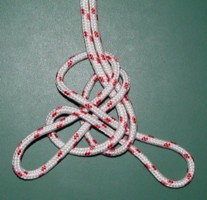 -4 -4
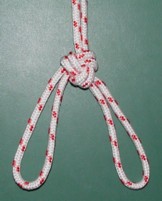 -5 -5
One advantage with the Triple Crown is that it can be tied in the middle of a rope when you don't have access to the ends of the rope (unlike the
Birmingham Bowline
and the
French/Portuguese Bowlines).
Additionally, the loops can't easily grow or shrink accidentally, so this knot is safer in that respect than the
French/Portuguese Bowlines
or the
Spanish Bowline.
However, it might be difficult to remember how to tie this knot when you need it.
I haven't been able to find any strength/security ratings for the Triple Crown.
Summary
I haven't seen anything written about the strength and security of the Birmingham Bowline or the French (Portuguese) Bowline, but they have an advantage in that the rope can easily be passed around an object while tying the knot. They have another potential advantage in that you can easily create any number of loops with these knots. One disadvantage is that these knots can't be tied in the middle of a rope (when you don't have access to the ends of the rope). Another potential disadvantage with the French/Portuguese Bowline is that some of the loops might accidentally change size, which can allow the load to shift dangerously.
With the Spanish Bowline, the rope can pass fairly easily between the two loops. This can be hazardous if it allows a heavy load to shift while being hoisted, lowered, or towed. In addition, the Spanish Bowline can be difficult to remember how to tie if you don't use it very often.
The Triple Crown is an attractive knot with splayed loops (in other words, the two loops don't lay on top of each other). However, not much is written about this knot, so I can't tell what kind of track record it has.
The Bowline on the Bight has a long track record as a rescue harness, and many lives have been safely entrusted to this knot. If you know how to tie the basic Bowline properly then this is a fairly easy knot to remember how to tie, and it's quick and easy to tie and dress (more so than the Double Figure-Eight Loop), and it can be tied in the middle of a rope when you don't have access to the ends of the rope. It's also easy to untie after it has been under a strain. Its strength rating is generally regarded as being 10-15% less than the Double Alpine Butterfly or the Double Figure-Eight Loop, but again, it has a long track record of safely being used in rescue situations.
The Triple Bowline can be tied in the middle of a rope when you don't have access to the ends of the rope, but I haven't been able to find any strength/security ratings for this knot.
The Double Figure-Eight Loop is preferred by many climbers rather than the Bowline on the Bight, although climbers sometimes use the Double Figure-Eight Loop in some situations and the Bowline on the Bight in other situations. The Double Figure-Eight Loop is generally considered to be strong and secure, and in my experience it's easier to untie than the basic Figure-Eight Loop.
The Double Dragon seems to rival the Alpine Butterfly in many ways, and the same seems to be true for the Double Double Dragon. It's easy to tie, and it's easy to convert a single-loop Double Dragon to a double-loop Double Dragon (and a double-loop Double Dragon to a triple-loop Double Dragon). The Double Double Dragon can be tied
before
using the two loops, or the two loops can be tied around an object
while
the knot is being tied. The single-loop Double Dragon can be difficult to untie if both ends of the rope have been under a heavy strain, but I don't know if this is true for the Double Double Dragon.
ABOK #1100 is Ashley's splayed double loop based on the Alpine Butterfly. For certain applications, people sometimes prefer using splayed loops rather than loops which lay on top of each other.
The Double Alpine Butterfly doesn't seem to be widely known. It seems to have the same basic strength rating as the Alpine Butterfly (the core knot configuration is the same), and it's easy to tie and untie.
The Karash Double Loop appears to be quick to tie, and easy to untie after it has been under a strain, and it appears to be a strong and secure rescue knot.
Practice tying your favorite knots periodically (from different angles) so that you'll remember how to tie them when you need them.
I don't recall ever needing a double-loop knot or a triple-loop knot, so I can't say that I have a preference.
For other people's preferred knots, see the forum topics called
"Best of breed" knots?
and
Top ten most useful knots
at the International Guild of Knot Tyers.
"The Most Useful Rope Knots for the Average Person to Know -- Multi-Loop Knots"
URL: http://daveroot.neocities.org/knots/Knots_MultiLoops.html
Modification History
| 02/24/2011: |
Added a link to a method for tying the Bowline on the Bight around an object. |
| 02/11/2011: |
Added a comment that the Alpine Butterfly can be dressed into another configuration which is topologically equivalent to the Alpine Butterfly configuration but which distributes the forces differently (and is therefore best thought of as a different knot). |
| 12/15/2010: |
Added the Karash Double Loop and the Triple Bowline. |
| 01/13/2005: |
Added ABOK #1100 (Ashley's double loop based on the Alpine Butterfly). Added a link to the forum of the International Guild of Knot Tyers in which other people have described their preferred knots. |
| 04/15/2004: |
Added the Double Double Dragon. |
| 12/10/2002: |
New article. |
Dave Root
|
|